
The cuisine of New York City comprises many cuisines belonging to various ethnic groups that have entered the United States through the city. Almost all ethnic cuisines are well represented in New York, both within and outside the various ethnic neighborhoods.

Hoe is a Korean seafood dish that is eaten by trimming raw meat or raw fish. In addition to fish, it is also made with other marine products such as shrimp and squid, raw meat of land animals, and vegetable ingredients, but without any special prefix, it mainly refers to raw fish.

Kuksu or kuksi is a noodle dish in Koryo-saram cuisine: cuisine of the ethnic Koreans of the mainland former Soviet Union. It is served cold and often spicy with beef.
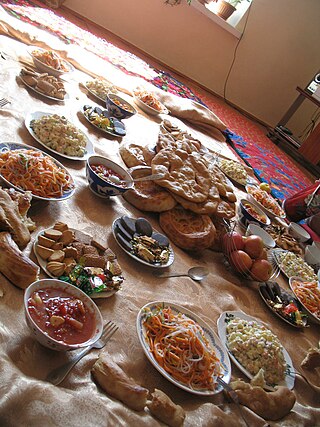
Central Asian cuisine has been influenced by Persian, Indian, Arab, Turkish, Chinese, Mongol, African and Russian cultures, as well as the culinary traditions of other varied nomadic and sedentary civilizations. Contributing to the culinary diversity were the migrations of Uyghur, Slav, Korean, Tatar, Dungan and German people to the region.
Koryo-saram or Koryoin are ethnic Koreans of the former Soviet Union, who descend from Koreans that were living in the Russian Far East.
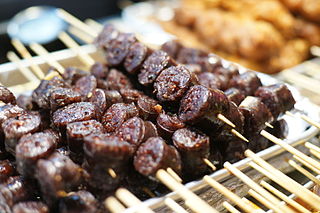
Sundae is a type of blood sausage in Korean cuisine. It is a popular street food in both North and South Korea, generally made by steaming cow or pig's intestines stuffed with various ingredients.

Carrot salad is a salad made with carrots. Recipes for carrot salad vary widely by regional cuisine. Shredded carrot is often used. Shredded carrot salads are often used as a topping for other dishes.

Morkovcha, also known as Korean-style carrots or Korean carrot salad, is a spicy marinated carrot salad. It is a dish in Koryo-saram cuisine, and is a variant of kimchi.

Jjinppang is a steamed bun, typically filled with red bean paste with bits of broken beans and bean husk. Traditional jjinppang is made of sourdough fermented using the yeast in makgeolli, but younger varieties such as hoppang are often made without fermentation. Warm jjinppang is softer than baked breads due to the higher moisture content, but it hardens as it cools. Thus it is recommended to eat while the bun is still hot. Hardened jjinppang can be steamed again before eaten.
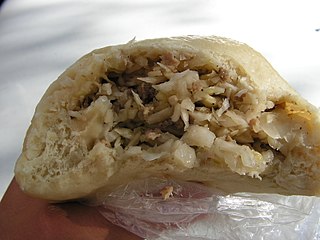
Pyanse or pigodi is a Sakhalin Korean steamed pie, bun, or dumpling stuffed with cabbage and meat. It is a popular dish in the Russian Far East, as well as in Koryo-saram communities of Central Asia.

Begodya is a dish in Koryo-saram cuisine: cuisine of ethnic Koreans of the mainland former Soviet Union, especially in Central Asia. It has been compared to the Korean steamed bun jjinppang. They can be filled with various meats and cabbage.

Funchoza or salat funchoza is a dish in Koryo-saram cuisine. It is variant of the Korean dish japchae, created by the Koryo-saram: a group of the Korean diaspora of the former Soviet Union.
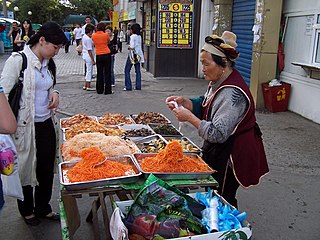
Koryo-saram are ethnic Koreans of the former Soviet Union. They have a distinct style of cuisine that is descended from Korean cuisine and influenced by the cuisines of various countries they have lived in. They are often considered distinct from Sakhalin Koreans, another Korean group from the former Soviet Union that has their own cuisine.

The Ussuriysk Korean Cultural Center is a branch of the South Korean organization Korean Cultural Centers in Ussuriysk, Primorsky Krai, Russia. It was built in 2009, and serves as an activity center for Koryo-saram: ethnic Koreans of the former Soviet Union. It also houses the Maritime Territory Koryo-saram Cultural Association.

Gwangju Koryoin Village (Korean: 광주고려인마을) is an enclave of Koryo-saram in Wolgok-dong, Gwangsan District, Gwangju, South Korea. Along with Ansan's Ttaetgol Village, it is one of the largest communities of Koryo-saram in the country. It had around 7,000 Koryo-saram residents by 2022.

Ttaegol Village (Korean: 땟골마을), alternatively Ddaetgol Village, is an enclave of Koryo-saram in Seonbu-dong, Danwon District, Ansan, Gyeonggi Province, South Korea. In Russian, the area goes by Ttekkol Samgori, where "samgori" is Korean for "three-way intersection". Around August 2022, around 7,000 people in the village were Koryo-saram. Along with Gwangju Koryoin Village, it is one of the largest Koryo-saram enclaves in the country.
Sakhalin Koreans are a group of ethnic Koreans on the island of Sakhalin, Russia. They have a distinct style of cuisine that descends from Korean cuisine and Russian cuisine. They are often considered distinct from Koryo-saram, Koreans of the former Soviet Union, whom have their own cuisine.
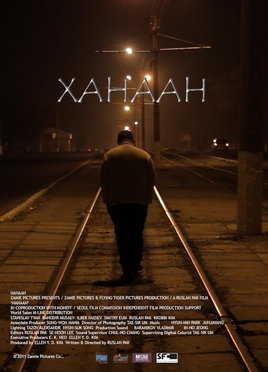
Hanaan is a 2011 Uzbek-South Korean drama film by director Ruslan Pak.
All Nations Baptist Church is a Russian-language Baptist congregation in the Park Slope neighborhood of Brooklyn, New York City, United States. It shares facilities with the Park Slope Community Church. The congregation is often associated with Koryo-saram: ethnic Koreans of the mainland former Soviet Union. It has been described as the only such Koryo-saram church in New York City.

















